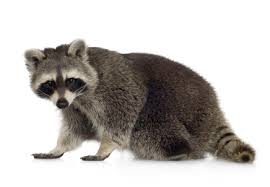.jpg)
RACCOONS
Written by S.L.C
Part of the community
INTRO
The raccoon (sometimes spelled with one c,) also known as the coon, is a medium-sized mammal native to North
America.having, a body length of 40 to 70 cm and a body weight of 8 to 20 lb. Its gray coat mostly consists of dense fur
which protects them from the cold. Two of the raccoon's most unique and charactoristic features are its extremely handy
front paws and its facial mask. Raccoons have been known for their intelligence, with studies showing that their memory
consists of 3 years. The diet of the omnivorous and sometimes nocturnal raccoon, is about 67% animals, and 33% plants.
.jpg)
HABITAT
These wall to wall mammals are found in forests, prairies, marshes, and even in urban areas. They can adapt to these
areas because of their dexterous paws, and its very long fingers.As an adaptable liver and feeder, raccoons will eat fish,
mice, bugs, eggs, and plain trash. BUt before eating, Raccoons wash their food by rapidly dunking it in nearby ponds or
lakes, and if cases are unfortunate, any habitat with a water source. When it comes to searching for a last resort place to
camp, These raccoons may have to deal with living in a a tree hole, log that have fallen, or an attic.

LIFE
Based on climate,Raccoons do not hibernate. During the winter raccoons are known to sleep for long periods of time, but do not hibernate. IN the spring, raccoons climb easilly, which eventually leads them up to 35 to 40 feet in the air. As well as
being skilled climbers, In the summer, these mammals are very strong swimmers, but they do not like to enter the water
because swimming tends to make them put on a little extra weight. Raccoon family groups are quite social and will feed and den together into the fall.
BEHAVIORS
Raccoons communicate in gender-wise social behaviors and are not typically self-governed engagers, as people used to
think. Females mostly live in a so-called "fission-fusion society", which means they share common areas and occasionally meet at feeding and/or resting grounds.The shape and size of a raccoon's territory may be a variety depending on its maturity, and habitat, with adults claiming lands more than twice as large as non-matured raccoons.

LIFE EXPECTANCY
Captive raccoons On average live for more than 20 years. However,raccoons in the wild live up to only 1 to 3 years. Young raccoons are most likely to lose their mother and to starvation, due to weather conditions or the youngs wandering off.The main natural predators of the raccoon are bobcats, coyotes, and great horned owls, but those animals' prey are just the young raccoons. In areas of the Soviet Union, the main predator of any raccoon is the wolf.
HEALTH
Raccoons may carry a dangerous lethal disease tranmitted through the teeth that is known as rabies. Out of all 6940 rabies cases in the US in 2006, (37.7%) were transmitted through raccoons. Suprisingly, there has only been one fatal case of raccoon rabies.
©2014 Heisenberg Community
Video coming soon!